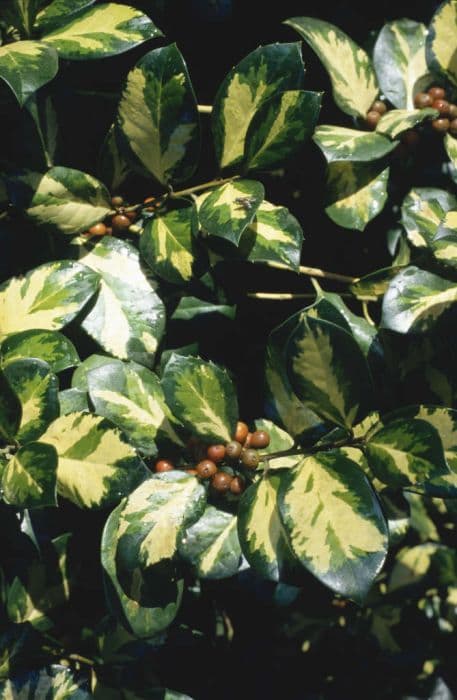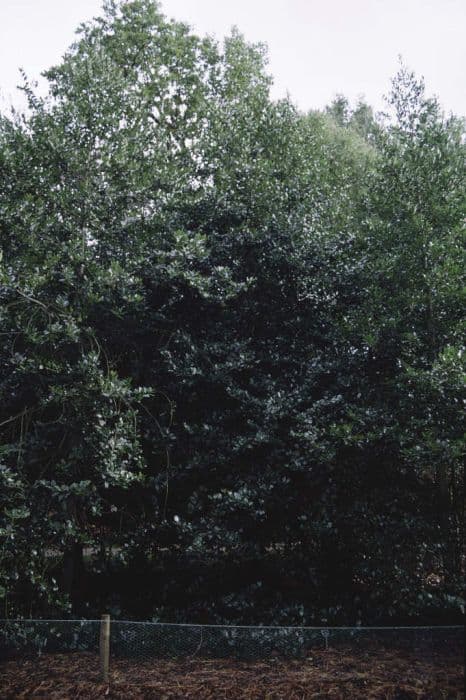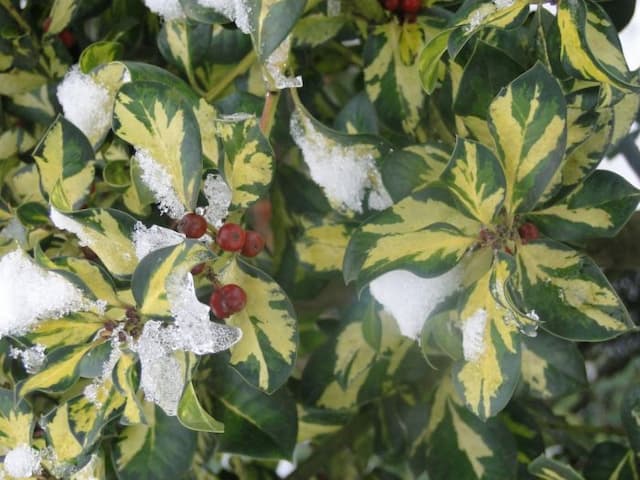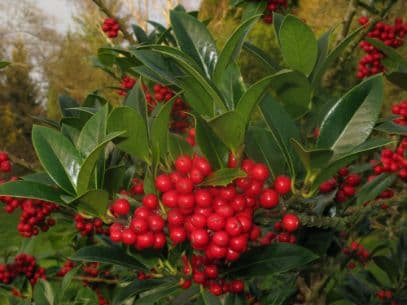Highclere Holly Ilex × altaclerensis

ABOUT
Ilex × altaclerensis, commonly known as Highclere holly, is a hybrid evergreen shrub with a dense, bushy growth habit. Its appearance is highlighted by the glossy, dark green leaves, which typically have a classic holly shape—with a spiny and wavy margin that can appear almost leather-like in texture. The leaves of the Highclere holly are often oval with a pointed tip and can produce a striking effect when they catch the light, creating a shimmering display in a garden setting. The Highclere holly is also known for its decorative berries, which are typically bright red and stand out against the dark foliage. These berries are produced in abundance, provided there is a pollination partner nearby, and can add a vibrant splash of color to the plant, particularly in the winter months when the contrast with the green leaves is most pronounced. During the blooming season, the Highclere holly produces small, white flowers. These blossoms are relatively inconspicuous when compared to the bold statement of the foliage and berries, but they do contribute to the overall attractiveness of the plant, adding a subtle texture and depth to the greenery. Overall, the appearance of the Highclere holly makes it a favored choice for gardens and landscapes where its year-round visual interest, emphasized by its foliage, flowers, and berries, can be a focal point or a backdrop to other garden features.
About this plant
 Names
NamesFamily
Aquifoliaceae
Synonyms
Highclere Holly
Common names
Ilex × altaclerensis.
 Toxicity
ToxicityTo humans
Highclere holly, a hybrid holly variety, is considered mildly toxic to humans. Ingestion of leaves or berries may result in gastrointestinal upset and symptoms, such as nausea, vomiting, diarrhea, and abdominal pain. Generally, a significant amount of plant material needs to be consumed to cause severe toxicity. However, children are more vulnerable to the toxic effects due to their smaller body size, and even small amounts can be more dangerous for them. Highclere holly should be treated with caution, and plant parts, especially berries, should be kept out of reach of children to prevent accidental ingestion.
To pets
Highclere holly is also regarded as mildly toxic to pets, including dogs and cats. If pets consume the leaves or berries, they could experience gastrointestinal upset, which is commonly characterized by symptoms like vomiting, diarrhea, and abdominal pain. In more severe cases, or if a large amount is ingested, pets may show signs of depression, decreased appetite, and extreme lethargy. It is important to prevent pets from accessing Highclere holly plants to avoid potential toxicity. If you suspect your pet has ingested a part of the plant, it is advisable to consult with a veterinarian.
 Characteristics
CharacteristicsLife cycle
Perennials
Foliage type
Evergreen
Color of leaves
Green
Flower color
White
Height
8-15 feet (2.4-4.5 meters)
Spread
8-15 feet (2.4-4.5 meters)
Plant type
Shrub
Hardiness zones
6
Native area
Cultivar
Benefits
 General Benefits
General Benefits- Aesthetic Appeal: Highclere holly's glossy foliage and attractive shape can enhance the visual appeal of gardens and landscapes.
- Habitat for Wildlife: It provides shelter and berries for birds, making it a valuable plant for supporting local ecosystems.
- Privacy Screen: The dense growth habit of Highclere holly makes it suitable for use as a hedge or screen, providing privacy for outdoor spaces.
- Low Maintenance: This plant is known for being hardy and requiring minimal maintenance once established, making it a convenient choice for gardeners.
- Tolerance of Conditions: Highclere holly can withstand a range of soil types and is also tolerant of salt spray, making it suitable for coastal areas.
- Year-Round Interest: With evergreen leaves and seasonal berries, it offers visual interest throughout the year, contrasting nicely with other plants in a garden.
- Versatility in Landscaping: It can be used in various landscaping designs, including formal gardens, foundation plantings, and as a specimen plant.
 Medical Properties
Medical PropertiesThis plant is not used for medical purposes.
 Air-purifying Qualities
Air-purifying QualitiesThis plant is not specifically known for air purifying qualities.
 Other Uses
Other Uses- The Highclere holly can be used as a natural dye source, providing subtle green pigments for textiles when the leaves are processed.
- Highclere holly wood, due to its density and fine grain, is sometimes used in woodturning for crafting ornamental objects or tool handles.
- The plants can be grown as a living hedge to create privacy barriers in gardens and parks, taking advantage of their dense foliage.
- When pruned into topiary forms, Highclere holly can serve as impressive focal points in formal garden designs.
- The spiny leaves of the Highclere holly can act as a deterrent against garden pests and animals when planted around the perimeters of vegetable gardens.
- During Christmas time, branches of the Highclere holly can be used for wreath making or holiday decorations due to their vibrant, evergreen leaves and red berries.
- The dense canopy of the Highclere holly can be used to provide shade for understory plants that do not thrive in direct sunlight.
- Smaller branches and stems can be used in floral arrangements as sturdy and visually appealing support for other stems.
- In landscape design, this plant can be used to create focal points or to add structured lines within a naturalistic setting due to its ability to be shaped and maintained.
- Highclere holly berries can be used for crafting decorative items, but care must be taken as they are not edible and can be toxic if ingested.
Interesting Facts
 Feng Shui
Feng ShuiThe plant Highclere holly is not used in Feng Shui practice.
 Zodiac Sign Compitability
Zodiac Sign CompitabilityThe Highclere holly is not used in astrology practice.
 Plant Symbolism
Plant Symbolism- Protection: Ilex × altaclerensis, commonly known as Highclere holly, is a member of the holly family. Holly plants in general are often associated with protection due to their spiky leaves, which were believed to ward off evil spirits.
- Good Fortune: Holly is also known to symbolize good luck and is often used in decorations during the winter holidays with the belief that it brings good fortune to the household.
- Perseverance: As an evergreen plant, the Highclere holly represents endurance and the ability to overcome challenges, much like it endures through the winter months.
 Water
WaterThe Highclere holly should be watered deeply and the soil allowed to partially dry out before the next watering to prevent root rot. During the growing season, water the plant once every week with about 1 to 1.5 gallons, depending on the weather conditions and soil drainage. In the winter, reduce watering to every two to three weeks, allowing the soil to dry out more between watering sessions. It's essential to ensure that the plant has well-drained soil to avoid waterlogging.
 Light
LightHighclere holly thrives in full sun to partial shade conditions. It is best to plant it in a spot where it can receive at least four to six hours of direct sunlight daily, while also having some protection during the hottest part of the day. Avoid deep shade areas, as this can lead to sparse foliage and poor growth.
 Temperature
TemperatureHighclere holly prefers moderate temperatures and can generally tolerate a range from the low 20s to upward of 100 degrees Fahrenheit. The ideal temperature range for this plant is between 50 and 70 degrees Fahrenheit. It can survive brief periods of colder winter temperatures, but prolonged exposure to temperatures below 20 degrees Fahrenheit may damage or kill the plant.
 Pruning
PruningPrune Highclere holly to maintain its shape and encourage bushier growth, this is typically done in late winter or early spring before the onset of new growth. Remove any dead, diseased, or crossing branches to improve air circulation and overall plant health. Pruning can be done annually or as needed to keep the desired shape and size.
 Cleaning
CleaningAs needed
 Soil
SoilHighclere Holly prefers a well-drained, loamy soil with a slightly acidic to neutral pH ranging from 5.5 to 7.0. The best soil mix would be two parts garden soil, one part peat moss, and one part perlite to ensure drainage.
 Repotting
RepottingHighclere Holly should be repotted every 3-5 years during spring. Older, well-established plants may not need frequent repotting unless they become root-bound.
 Humidity & Misting
Humidity & MistingHighclere Holly thrives in moderate humidity levels typical of outdoor environments, so striving for 40-50% relative humidity is suitable for this plant.
 Suitable locations
Suitable locationsIndoor
Ensure bright, indirect light and moderate humidity.
Outdoor
Plant in partial shade, shelter from strong winds.
Hardiness zone
6-9 USDA
 Life cycle
Life cycleHighclere holly (Ilex × altaclerensis) begins its life as a seed, which after stratification, germinates in the spring. The seedling grows slowly, developing a woody stem and glossy green leaves with maturity. As it enters the juvenile phase, it establishes a root system and foliage but does not yet flower. Upon reaching maturity after several years, it produces small white flowers which, if pollinated, will lead to the formation of red berries. These berries are then dispersed by birds and animals, enabling the cycle to continue with new seedlings. The plant exhibits continued growth in size and shape, and can undergo cycles of flowering and berry production annually for many years, often living for a century or more if conditions are favorable.
 Propogation
PropogationPropogation time
Spring-Early Summer
The most popular method of propagating the Highclere Holly, Ilex × altaclerensis, is through semi-hardwood cuttings. This process is typically carried out in late summer to early autumn when the current year's growth has matured enough to be semi-woody but is not yet fully hardened. Cuttings should be about 4-6 inches (10-15 cm) long and include several leaf nodes. The lowest leaves are removed, and the cut end of the cutting can be dipped into a rooting hormone to enhance root development. The prepared cutting is then inserted into a pot filled with a moist, well-draining potting mix. It should be placed in a warm, shaded area and kept consistently moist. With proper care, roots will develop in a few months, after which the new Highclere Holly plants can be gradually acclimated to more direct light and eventually planted out.









